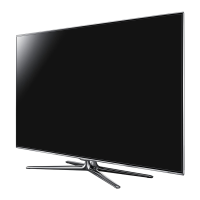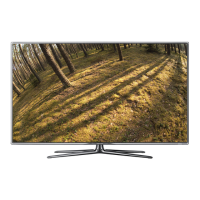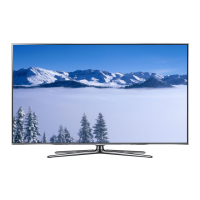
Do you have a question about the Samsung UN55D7050 and is the answer not in the manual?
| Screen Size | 55 inches |
|---|---|
| Display Type | LED |
| Resolution | 1920 x 1080 |
| Refresh Rate | 240Hz |
| Smart TV | Yes |
| 3D Capable | Yes |
| HDMI Ports | 4 |
| USB Ports | 3 |
| Wi-Fi | Yes |
| Ethernet Port | Yes |
Warning about displaying still images to prevent screen burn-in and maintain image quality.
Preparation steps before installing a wall-mount from another manufacturer.
Detailed steps for installing the wall mount kit for your TV.
Specifications for VESA compliant wall mount kits, including screw sizes.
Overview of the remote control's side view and button functions.
Instructions on how to insert batteries into the QWERTY remote.
Steps for the initial pairing process between the QWERTY remote and the TV.
Guide for connecting AV devices using HDMI or HDMI to DVI cables for HD output.
Instructions for connecting audio devices using optical or analog cables.
Guide for connecting a PC using HDMI, HDMI to DVI, or D-sub cables.
How to select TV or external input sources for the TV.
Associating a device name to an input source for easier selection.
Setting external input sources as favorites for quick access.
Instructions for connecting the TV to a LAN via a wireless router or modem.
Steps for configuring wireless network connections using DHCP.
Steps for configuring wired network connections using DHCP.
Description of the TV screen display during e-Manual navigation.
How to use the Help function to access the e-Manual Guide or Product Guide.
Guide on switching between e-Manual topics and OSD menus.
Steps for installing the TV-Holder kit to secure the TV to the wall.
Guidelines for storing and maintaining the TV to ensure proper operation.
Technical specifications for the QWERTY remote control.
Diagrams showing the front and side views with dimensions.
Diagrams showing the rear jack panel details and dimensions.
Federal Communication Commission interference statement for the device.
Canadian ICES-003 statement for digital apparatus compliance.
Explanation of the Eco Sensor feature and its impact on picture brightness.
Instructions for redeeming 3D Active Glasses online.
Instructions for redeeming 3D Active Glasses via mail.
Terms and conditions for the 3D Active Glasses offer.
How to access and navigate the Channel menu on your TV.
Function to manage scheduled channel viewings using Timer Viewing.
Viewing and managing your favorite TV channels.
Selecting the antenna source (Air or Cable) for channel memorization.
Function to filter out scrambled channels after Auto Program.
Selecting preset picture adjustments for optimal viewing experience.
Adjusting key picture quality settings like brightness and contrast.
Options for adjusting picture size and aspect ratio for optimal viewing.
Advanced picture adjustments for fine-tuning image quality.
Automatically adjusts picture frequency, position, and fine-tuning for PC mode.
Configuring video settings on Windows XP for PC display.
Selecting preset sound modes for optimal audio experience.
Adjusting sound effects like SRS TruSurround HD and TruDialog.
Methods for connecting the TV to a LAN using a cable connection.
Steps to automatically set up the TV's network connection via DHCP.
How to find network connection values on Windows computers for manual setup.
Instructions for connecting the TV to a LAN through a wireless router.
Steps to automatically set up the TV's wireless network connection.
How to find network connection values for manual wireless setup.
Steps to set up wireless network connection using WPS (Push Button Configuration).
Steps to connect to a mobile device supporting Ad-hoc connections.
Setting the TV's clock for timer features and automatic time synchronization.
Configuring the TV to turn on automatically at a set time and day.
Setting up PIN and program rating locks for parental control.
Adjusting TV brightness and settings to reduce power consumption.
Enabling Game Mode for a more realistic gaming experience.
Important notes regarding the use and limitations of Game Mode.
Explanation of the Anynet+ (HDMI-CEC) function and device compatibility.
Setting the display language for the TV's on-screen menus.
Enabling or disabling the closed captioning function.
Selecting the desired caption mode based on broadcast availability.
Legal notices and disclaimers related to the product's operation.
Using the picture test to check for display problems and faults.
Information about the currently installed software version on the TV.
Enabling and using the 3D viewing feature with Samsung 3D Active Glasses.
Guide to using the ABC type keypad for text input in Smart Hub.
Accessing account management, reset, and properties functions for Smart Hub.
Instructions on how to play video files from a connected device.
How to play music files from a connected device using Smart Hub.
How to view individual photos or start a slide show.
How to sort files in lists by various criteria like title, date, or artist.
Description of the Dock Mode display and its features.
Enabling or disabling the AllShare media function for connected devices.
Explanation of the Anynet+ (HDMI-CEC) function and device compatibility.
Enabling or disabling the Anynet+ (HDMI-CEC) function.
Troubleshooting steps for common picture quality issues like distortion or brightness.
Troubleshooting steps if 3D glasses are not functioning properly.
Tips for improving 3D image quality and viewing experience.
Tips for extending battery life of 3D glasses.
Step-by-step instructions for physically securing the TV using a Kensington Lock.
Initial setup steps for connecting the TV to a network and configuring Smart Hub.
Overview of key features and components within the Smart Hub interface.
Easily search and access content from diverse sources within Smart Hub.
Share TV viewing experiences with friends via social networking services.
Personalize movie watching with a customized video on demand recommendation service.
Access the internet and surf the web directly on your TV.
Verify all cable connections are secure and devices are properly plugged in.
Cycle through input sources to ensure the correct video source is selected.
Power cycle the TV and connected external devices to resolve potential issues.
Re-run the initial setup process for optimal TV configuration.
Perform Picture Test, Sound Test, and Network Status Test for diagnostics.
Consult the TV's user manual for detailed troubleshooting information.
Access internal troubleshooting guides through the TV's support menu.
Access online support resources, including how-to videos and troubleshooting tips.
Download and install the latest TV firmware for optimal performance.
Contact Samsung customer support for further assistance.











